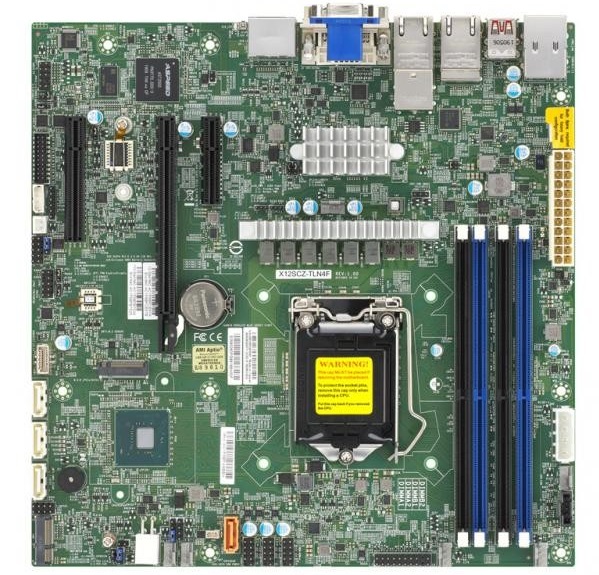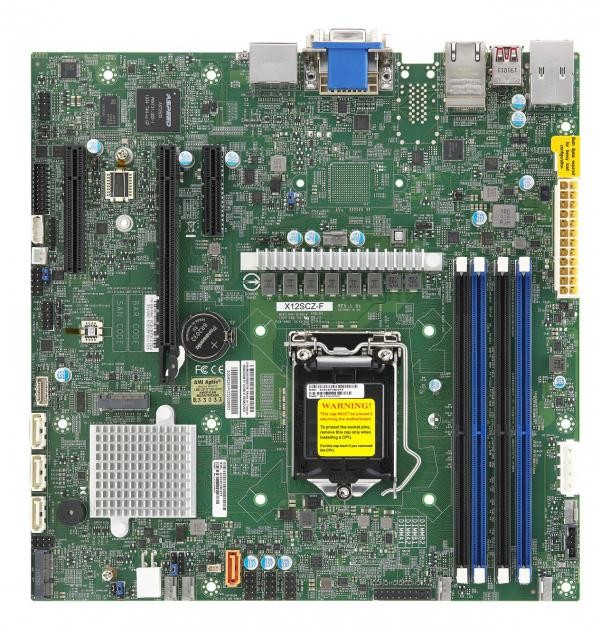The Intel W480 Motherboard Overview: LGA1200 For Xeon W-1200
by Gavin Bonshor on June 24, 2020 9:00 AM ESTSupermicro X12SCZ-TLN4F & X12SCZ-F
For the launch and release of Intel's W480 chipset, Supermicro has prepared a handful of models, each with different configurations to cater to various user needs. Two of Supermicro's W480 models come via the X12SCZ-F and X12SCZ-TLN4F, which share the same core micro-ATX PCB layout, with its green PCB, and black and blue slots. The only difference between both models aside from a few visual differences comes in the controller set. The Supermicro X12SCZ-TLN4F includes dual Intel 10 GbE Ethernet, a single PCIe 3.0 x4 M.2, and four SATA, while the X12SCZ-F opts for dual Gigabit Ethernet.

Supermicro X12SCZ-TLN4F micro-ATX motherboard
Visually, there's not much difference between the Supermicro X12SCZ-F and X12SCZ-TLN4F aside from the heatsink layout. On the latter, there's a heatsink cooling the Intel X550 10 GbE T-Base dual Ethernet controller, while the X12SCZ-F has a heatsink cooling the W480 chipset. This also includes a transposed socket design for installation into rackmount and 1U chassis. Aside from the networking and the onboard audio, both models are identical in specification and design. This includes one full-length PCIe 3.0 x16 slot, with a half-length PCIe 3.0 x4 slot, and a single PCIe 3.0 x1 slot. For storage, there's one PCIe 3.0 x4 M.2 slot, with four SATA ports with support for RAID 0, 1, 5, and 10 arrays. An additional PCIe 3.0 x1 M.2 Key-E slot is also present on both boards.
Focusing on memory support, both the X12SCZ-TLN4F and X12SCZ-F includes four memory slots, with support for up to DDR4-2933 of ECC and non-ECC memory, with a maximum capacity of up to 128 GB. Both models also include an Aspeed AST2500 BMC controller with a D-sub to access the IPMI physically. Supermicro also features memory error detection with the detection of double-bit errors using ECC memory and the correction of single-bit memory errors across all memory types used.

Supermicro X12CZ-F micro-ATX motherboard
As previously mentioned, the only difference between both models is that the X12CZ-TLN4F opts for an Intel X550 10 GbE T-Base dual Ethernet controller, with two additional Ethernet ports with one controlled by an Intel I219LM controller, and another by an Intel I120-AT. The Supermicro X12SCZ-F includes two Ethernet controllers consisting of an Intel I219LM and I210-AT Gigabit controller pairing. Both models include four USB 3.2 G2 Type-A ports, with two DisplayPort video inputs, a D-sub for the boards IPMI, and a serial port. Both models use a Realtek ALC888S HD audio codec for the onboard audio, but Supermicro doesn't specify how this translates to rear panel audio connections.
The Supermicro X12CZ-TLN4F includes superior networking support with dual Gigabit Ethernet ports and a dual 10 GbE T-Base Ethernet, while the X12CZ-F opts for dual Gigabit Ethernet. Both models include a solid professional feature set including an Aspeed AST2500 BMC controller which allows IPMI access physically via a D-sub video output, or via remote access which includes KVM support. Supermicro at present hasn't unveiled pricing on any of its W480 models, as it expects to sell them to system integrators only.










38 Comments
View All Comments
duploxxx - Thursday, June 25, 2020 - link
Intel don't need to compete with threadripper. This workstation chipset will move to all default OEM workstations as usual. OEM that are affraid to change anything on there portfolio because of R&D funding budgets from Intel to keep using there chipsets and cpu. IT will swallow it anyhow as they see still Intel as the only fit for business.... and also because the decision body is most of the time led by people who are sitting far to long at an IT desk thinking they still know anything about HW. 100000's of these workstations will just be business as usual, CVE, underwhelming core performance vs competition, heat, it does not matter the only thing OEM (Dell, HPinc, ...) will offer are Intel based workstation. We use 1000's a year asking several years to get an alternative into the Z offering from HPinc to getdecent pricing on +10 cores …. the only answer is "we will look into it"Dr_b_ - Monday, September 21, 2020 - link
"This doesn't even compete with Threadripper, much less Epyc."Its not trying to. TR and EPYC are in a different cost tier entirely. Why would you buy a TR or EPYC and pay more, if you didn't need the number of cores or lanes they offered, and if your workloads weren't going to utilize those cores or lanes. And if you needed those cores and lanes, you wouldn't be looking at this segment. Think edge computing tasks, SMB, storage, virtualization.
Intel also offers stability, and an IPC advantage, at least for now. Maybe ZEN3 comes along and changes the game, at least in terms of IPC, but the jury is still out on stability. Poor QA, insufficient testing and qualification, and really bad software, seems to be a systemic issue at AMD.
edzieba - Wednesday, June 24, 2020 - link
Different use-cases. If you buy a workstation with the attitude of "more cores must be more better!" you will very likely end up wasting money on a system that does not perform as well as one chosen for the tasks you will be performing.Deicidium369 - Wednesday, June 24, 2020 - link
Most people who opt for this board will use it as a small office server - and most would not even need to expand. Add a couple sticks of ECC or not memory, a couple of SATA drive and they would be set. several USB3.2 ports, 2.5Gb/s Ethernet and integrated graphics. Perfect small business server.MDD1963 - Saturday, June 27, 2020 - link
had a person on a forum tentatively planning on using an X299/ i9-7900X as the basis for a simple home media/file server build....(undoubtedly on a 1 GbE network at home, no less)Samus - Wednesday, June 24, 2020 - link
I think the lack of PCIe 4.0 is the sole deal breaker. Intel has it on their high end server platforms, why hasn't this filtered down to the workstation...you'd think they would just tweak the same chipset - the silicon support IS THERE in Comet Lake CPU's as they have already announced Rocket Lake (the same microarchitecture as Comet Lake) will support PCIe 4.0 later this year. I mean what is that going to require yet another chipset?Two totally different platform launched in the same year, really Intel?
Deicidium369 - Wednesday, June 24, 2020 - link
Vast majority of small businesses who would opt for this CPU could care less about PCIe4 or more cores.Rocket Lake S will be built on the same process as Comet Lake - but will be basically a Tiger Lake in architecture (Willow Cove, Xe LP 24EU). Z490 will support PCIe4 on some boards - but Rocket Lake will launch with the Z590 which will be PCIe4. Will be great to finally have PCIe4 reach mainstream status. Same LGA1200 socket, different chipsets.
Samus - Wednesday, June 24, 2020 - link
You are joking right? Why would somebody buy a high end workstation in June 2020 with PCIe 3.0, when PCIe 4.0 SSD's have been out for months and even the PlayStation 5, a VIDEOGAME CONSOLE, will have a PCIe 4.0 SSD next year, all the while Intel will be revising these CPU's and presumably the chipset around PCIe 4.0 within 6 months?Anybody buying into this platform is getting screwed. To say someone who wants a W1200 doesn't care about PCIe 4.0 is as ridiculous as saying someone who buys a Corvette doesn't care about 0-60.
PixyMisa - Wednesday, June 24, 2020 - link
Intel themselves are selling PCIe 4.0 SSDs. They just don't have anything that can use them at that speed.Foeketijn - Thursday, June 25, 2020 - link
No. These servers are the cheapest servers. That is the sole purpose. You want high end? You need a different platform. Box from the shelve. Install Windows server. Done.No upgrades, no performance parts. Just run it as long as it runs.